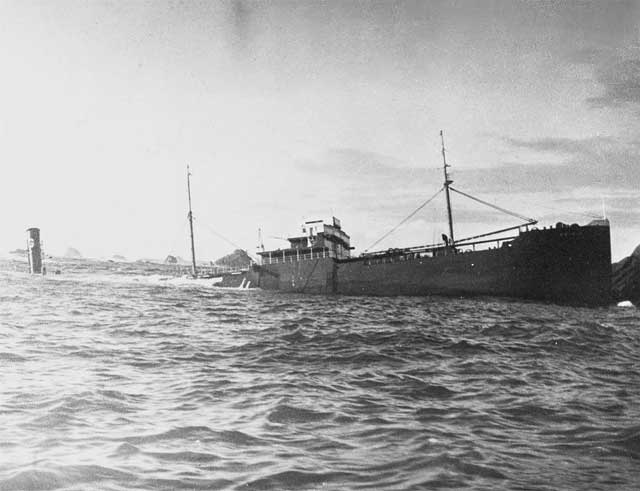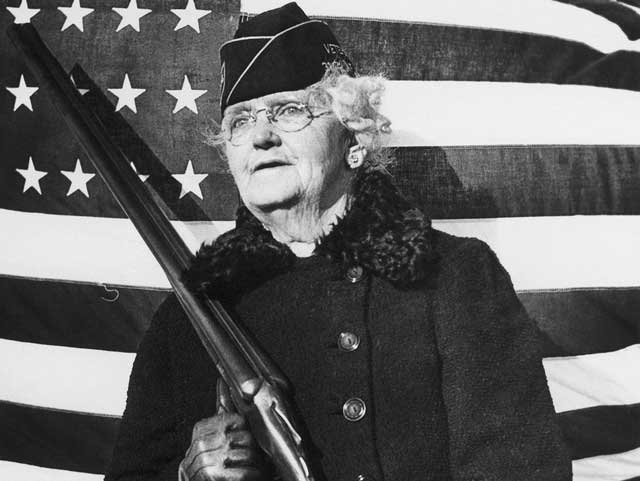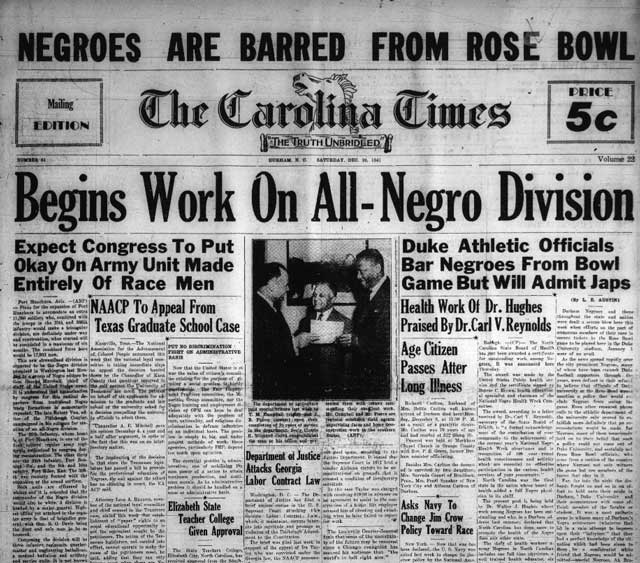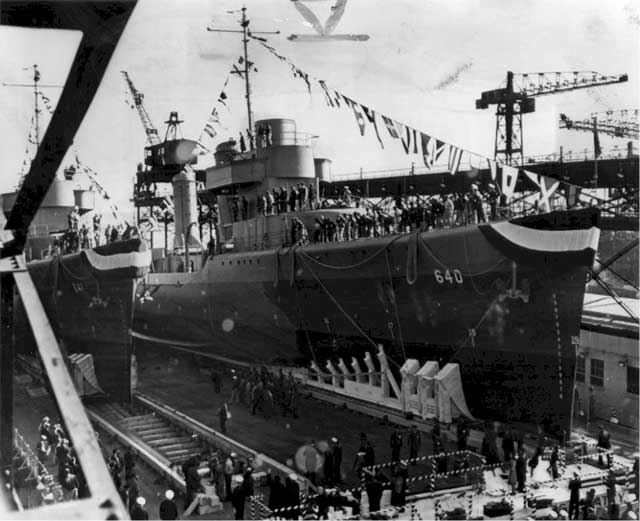Saturday 20 December 1941
 |
| Tanker Emidio sinking at Blunt's Reef off Point Mendocino, California, 20 December 1941. |
Battle of the Pacific: Japanese submarines are lurking off the U.S. west coast. On
20 December 1941, I-17 torpedoes, shells, and sinks 6912-ton U.S. tanker Emidio about twenty miles west of the California coast at Blunt's Reef (off Cape Mendocino). The attack is made on the surface and in daylight. There are five crew deaths. The survivors reach the Blunt's Reef lightship and are later rescued by Coast Guard cutter Shawnee. A Consolidated PBY Catalina flying boat searches for the submarine to no avail. The Emidio is the first US tanker definitely known to be torpedoed and lost in World War II (the Astral was lost in November 1941, but exactly how is not known with absolute certainty). The ship is abandoned and there is some hope of salvaging her, but the Emidio drifts onto the rocks off Crescent City and is wrecked. The is the closest to date that the war has gotten to the continental United States.
 |
| Another view of the sinking Emidio. |
At Hong Kong Island, the invading Japanese advance through the Wong Nai Chung Gap from the north to the south coast and split the island in two. British Commonwealth troops hold out on the Stanley Peninsula east of the gap and in the western part of the island. The Japanese troops capture the island's water reservoir, making a British surrender virtually inevitable.
 |
| American artist and cartoonist James Montgomery Flagg and his daughter Faith in Philidelphia, Pennsylvania, December 20, 1941. |
In Burma, the recently relocated American Volunteer Group (AVG, aka "Flying Tigers") enter their first combat east of Rangoon in their distinctive P-40B Tomahawk fighters. The unit is not officially part of the US Army Air Force and the pilots (aside from leader Major General Claire Chennault) do not hold commissions. This provides an unusual free-wheeling aspect to the operation, including $500 bounties for every Japanese plane the pilots shoot down. This date, 20 December 1941, is considered the "birth" of the Flying Tigers.
 |
| AVG Flight Leader Bob Layher, 1941-42. |
The Japanese make landings on Mindanao, the Philippines. For the first time, the Japanese take heavy casualties as well-placed Filipino machine gunners of the 101st Regiment pin down the invaders. The Japanese ultimately prevail by calling inshore bombardments by 5-inch naval guns. It is a striking mirror image of events later in the war. At Clark Field, the air echelon of the 30th Bombardment Squadron, 19th BG (Heavy), no longer has any bombers to service, as they all have been sent to Australia. Thus, they are sent to Batchelor Field, given rifles, and told to serve as infantry with the 5th Interceptor Command (Provisional).
 |
| "The Joy of a Father's Homecoming," December 20, 1941, The Toronto Star Weekly. |
At Wake Island, US Navy Task Force 11 (Admiral Frank Fletcher) and Task Force 14 (Admiral Wilson Brown) are sailing toward Wake Island. At Pearl Harbor, Vice Admiral William S. Pye - the Acting Commander in Chief of the U.S. Pacific Fleet - is very leery of the operation and keeps a close eye on any indications of a strong Japanese fleet presence in the area. A US Navy Catalina arrives at Wake bringing official mail and news of the relief expedition. The plane makes a quick turnaround and evacuates Major Walter J. Bayles, who comments:
I looked at our flag, still snapping in the breeze at the to of the pole where it had been hoisted on December 8. I looked at the cheerful, grinning faces and the confident bearing of the youngsters on the dock. As I waved a last good-bye and took my seat in the plane, my smile was as cheerful as theirs. I knew all would go well with Wake Island.
Nobody else will escape the island.
 |
| "A Fairey Albacore about to land on the deck of HMS VICTORIOUS during flying operations at Scapa Flow." 20 December 1941 (© IWM (A 6745)). |
Eastern Front: Adolf Hitler, having assumed direct command of the German Army, instructs OKH chief of operations General Franz Halder how the situation around Moscow is to be handled. The troops would require a "fanatical will to fight," and this would have to be enforced by "all, even the most severe, means." Soldiers would have to "tolerate breakthroughs" and fight where they stood, as nobody had any "contracts" limiting their efforts to logistics or anything else. Winter clothing could be taken from Soviet civilians or dead Red Army soldiers. He emphasizes, "Every man must defend himself where he is."
 |
| Mrs. Paul Titus of Bucks County, Pennsylvania poses on 20 December 1941. She had signed up as an air-raid spotter on 8 December 1941. Mrs. Titus is ready to defend Pennsylvania, declaring, "I can carry a gun any time they want me to." |
In the morning, General Guderian boards a light plane to fly to Fuehrer headquarters in East Prussia. The new commander of Army Group Center, Field Marshal Guenther von Kluge, receives a string of messages from his armies that suggest utter hopelessness. For instance, Fourth Army reports:
Enemy attacking in the army's deep flank, aiming toward Kaluga. Army has no more forces at its disposal. Combat strength sinking. Holding present positions not possible in the long run.
General Hoepner's Fourth Panzer Group sends a desperate message:
The Commanding Generals of 46 and 5 Corps have reported they cannot hold. Heavy losses of trucks and weapons in recent days. They had to be destroyed for lack of gasoline. Weapons now 25-30 percent of requirements. Only course to give orders to hold to the last man. The troops will then be gone and there will be a hole in the front.
General Strauss at Ninth Army is equally pessimistic:
Present battle area wooded and has poor visibility. If it has to hold there the army is likely to be broken through and smashed.
It is a bleak picture, but the front is holding for the time being.
 |
| The Louisville, Kentucky Courier-Journal of 20 December 1941 is getting closer to a realistic portrayal of the war than it and other papers had in the week following the attack on Pearl Harbor. However, its announcement of the "first big Philippine landing" is over a week late. |
The desperate situation gives von Kluge a chance to settle some old scores. After dark, he calls Halder and unloads his feeling about Guderian, who has clashed with Kluge throughout the campaign (as, to be fair, Guderian has done with several other generals). Kluge reports that he has learned that Guderian has been secretly moving troops to the Oka River, which is 40 miles east of where he is supposed to be. Halder immediately calls the Fuehrer Headquarters, where Guderian already is talking to Hitler. This leads to an immediate row, with Hitler screaming at Guderian that he has planned "an insane scheme." To Guderian's face, Hitler orders Guderian to hold his line right where it is and forget about further withdrawals. It is almost surprising that Guderian returns to the front still holding his command.
 |
| The 20 December 1941 (North) Carolina Times seems to be reporting on a completely different war than the one overseas. |
US Military: The US Navy continues its reorganization following the disaster at Pearl Harbor. Admiral Ernest J. King, the Atlantic Fleet commander, is designated Commander in Chief United States Fleet with headquarters in the Navy Department, Washington, D. C. While King is elevated from the Atlantic command, he maintains a fierce effort throughout the war to give adequate resources to the Pacific Theater.
German Homefront: Belatedly, Propaganda Minister Joseph Goebbels announces a winter relief drive for the troops on the Eastern Front, "Winterhilfswerk für Wehrmacht." The public is encouraged to donate warm clothing in a gesture of "solidarity with the troops." It is never made clear how desperate the situation is, but disturbing reports reach the homefront despite the government's rather casual handling of a very real crisis.
 |
| USS Tillman (DD-641) and USS Beatty (DD-640) on the ways in Charleston, South Carolina Navy Yard on 20 December 1941. They are about to be launched. USS Tillman (DD-641) is commissioned 9 June 1942, and USS Beatty (DD-640) is commissioned 7 May 1942. |
American Homefront: Glenn Miller and His Orchestra hit No. 1 on the Billboard chart with "Elmer's Tune." It is the song's only week at the top spot. It has Ray Eberle (who later joins the military) on lead vocals and the Modernaires on backing vocals. The song is named after the music composer, Elmer Albrecht.
Charles Lindbergh writes to Chief of Army Air Forces Henry H. "Hap" Arnold requesting a commission in the military. President Roosevelt is extremely angry at Lindbergh's efforts on behalf of the America First Committee and tells Arnold to deny the request.
 |
| The Emidio sinks off the California coast. |
December 1941
December 1, 1941: Hitler Fires von Rundstedt
December 2, 1941: Climb Mount Niitaka
December 3, 1941: Hints of Trouble in the Pacific
December 4, 1941: Soviets Plan Counteroffensive
December 5, 1941: Soviets Counterattack at Kalinin
December 6, 1941: Soviet Counterattack at Moscow Broadens
December 7, 1941: Japan Attacks Pearl Harbor
December 8, 1941: US Enters World War II
December 9, 1941: German Retreat At Moscow
December 10, 1941: HMS Prince of Wales and Repulse Sunk
December 11, 1941: Hitler Declares War on US
December 12, 1941: Japanese in Burma
December 13, 1941: Battle of Cape Bon
December 14, 1941: Hitler Forbids Withdrawals
December 15, 1941: The Liepaja Massacre
December 16, 1941: Japan Invades Borneo
December 17, 1941: US Military Shakeup
December 18, 1941: Hitler Lays Down the Law
December 19, 1941: Brauchitsch Goes Home
December 20, 1941: Flying Tigers in Action
December 21, 1941: The Bogdanovka Massacre
December 22, 1941: Major Japanese Landings North of Manila
December 23, 1941: Wake Island Falls to Japan
December 24, 1941: Atrocities in Hong Kong
December 25, 1941: Japan Takes Hong Kong
December 26, 1941: Soviets Land in the Crimea
December 27, 1941: Commandos Raid Norway
December 28, 1941: Operation Anthropoid Begins
December 29, 1941: Soviet Landings at Feodosia
December 30, 1941: Race for Bataan
December 31, 1941: Nimitz in Charge
2020











No comments:
Post a Comment